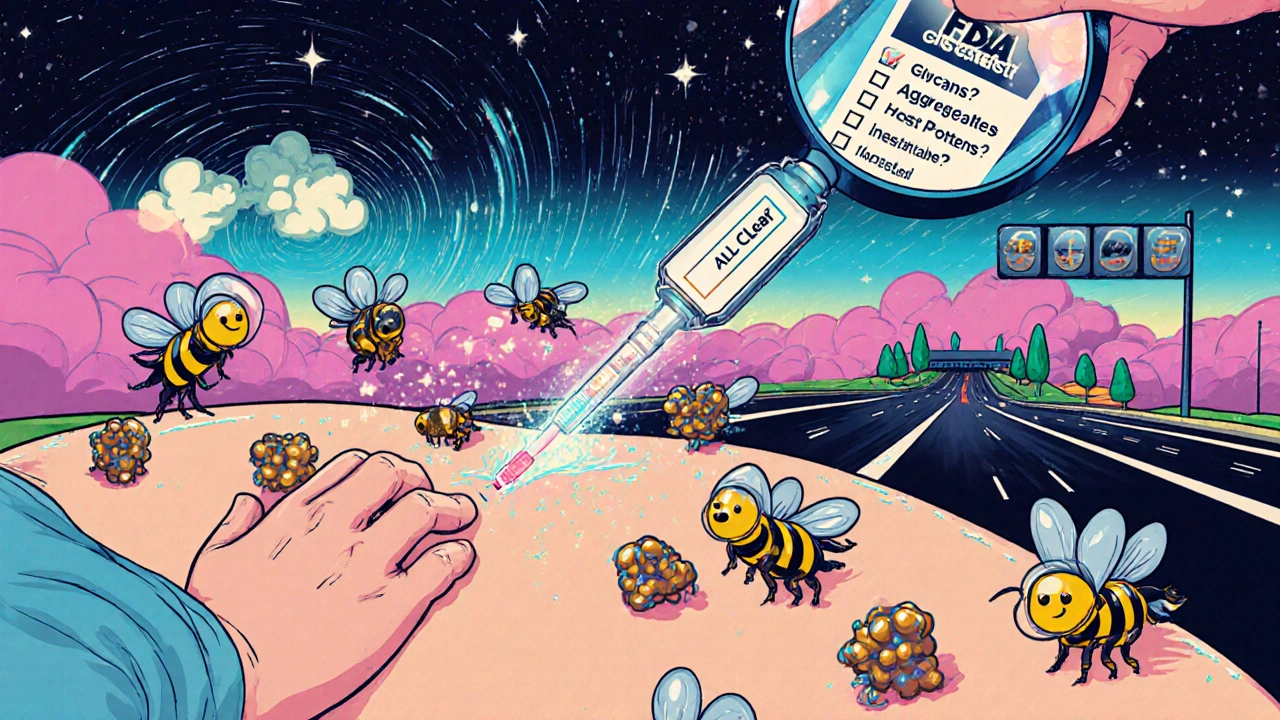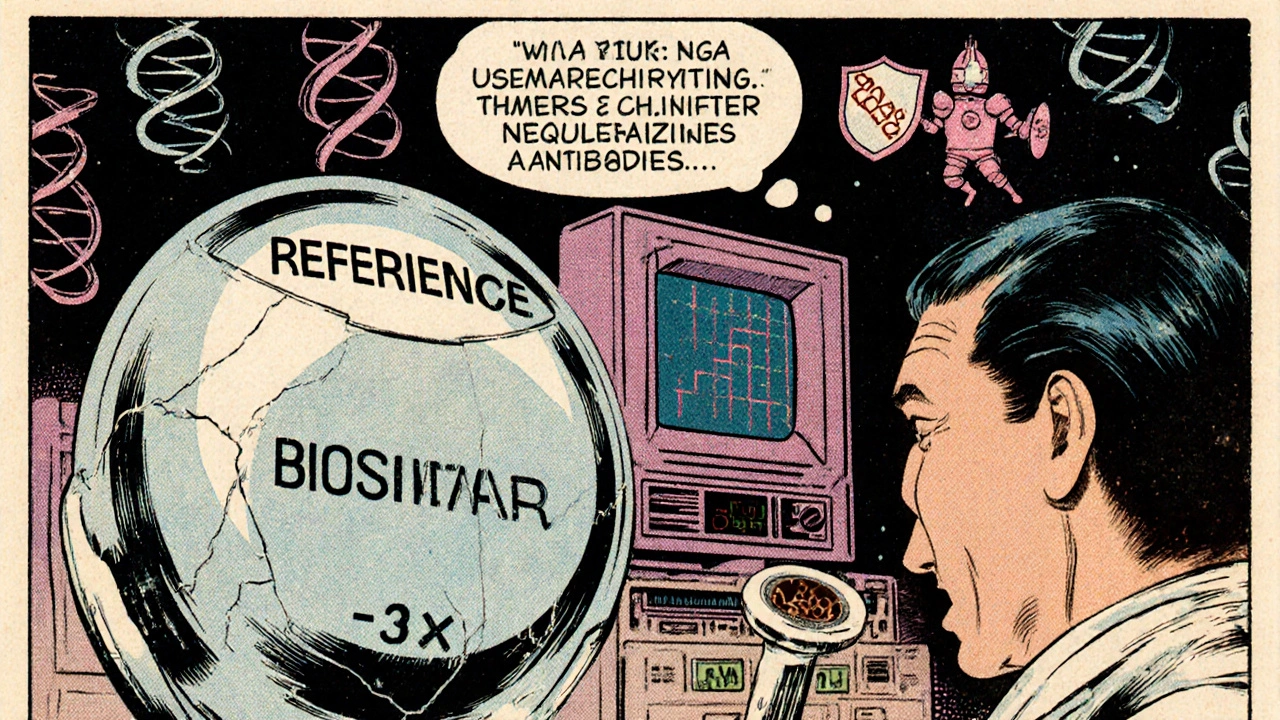Immunogenicity in Biosimilars: Why Immune Responses May Differ from Reference Biologics
 Nov, 26 2025
Nov, 26 2025
When you hear the word biosimilar, you might think it’s just like a generic pill-cheaper, same effect, no big deal. But that’s not true. Biosimilars aren’t chemical copies like generics. They’re made from living cells, and even tiny differences in how they’re grown or processed can change how your body reacts to them. One of the biggest concerns? Immunogenicity-the chance your immune system will see the drug as a threat and attack it.
Why Your Body Might Fight a Biosimilar
Your immune system is built to spot invaders. It doesn’t care if something is made in a lab or grown in a cell culture. If it looks foreign, it triggers a response. With biosimilars, that response can happen because of small changes in the protein’s shape. These aren’t mistakes-they’re natural results of complex manufacturing. A biosimilar might have slightly different sugar molecules (glycans) attached to its surface, or tiny clumps of protein (aggregates) that weren’t in the original drug. These differences are often below 1%, but your immune system doesn’t need much to notice.For example, if a biosimilar has more galactose or less sialic acid on its surface, it can change how immune cells interact with it. That’s not theory-it’s measurable. Studies show that even 5% more protein aggregates can increase the chance of anti-drug antibodies (ADAs) by over three times. And once those antibodies form, they can block the drug from working, or worse, cause allergic reactions. There’s a documented case where a drug for cancer triggered life-threatening anaphylaxis because of a sugar structure that hadn’t been present in the original version.
How Biosimilars Are Made (And Why It Matters)
Biologics and biosimilars are made using living cells-usually Chinese hamster ovary (CHO) cells or sometimes human cell lines. These cells act like tiny factories, producing complex proteins. But no two batches are exactly alike. Even slight changes in temperature, pH, or nutrient mix during growth can alter how the protein folds or what sugars get added. This is called post-translational modification. It’s not something you can control perfectly, even with the best equipment.Compare that to a generic pill. A generic aspirin has the exact same chemical structure as brand-name aspirin. You can dissolve it, test it, and it’s identical down to the atom. But a biosimilar? It’s like trying to recreate a handmade quilt. Same pattern, same thread, but every stitch is slightly different because the weaver’s hands move differently each time. That’s why regulators don’t call them “identical.” They call them “highly similar.” And that “highly” is where the science gets tricky.

What Triggers an Immune Response?
It’s not just the drug itself. Your body, your health, and how you take the drug all play a role. Someone with rheumatoid arthritis has a higher risk of developing ADAs than a healthy person. Why? Their immune system is already on high alert. Patients on methotrexate, a common arthritis drug, have up to 65% lower ADA rates because it calms the immune system down. Genetics matter too. People with a specific version of the HLA-DRB1*04:01 gene are nearly five times more likely to form antibodies against certain biologics.How you get the drug also changes the risk. Shots under the skin (subcutaneous) are more likely to trigger immunity than IV infusions. Why? Subcutaneous delivery exposes the drug to immune cells in the skin and fat tissue, which are packed with antigen-presenting cells. IV delivery sends the drug straight into the bloodstream, where it’s diluted and processed differently. Studies show subcutaneous use can increase immunogenicity risk by 30-50%. And if you’re on the drug for more than six months, your body has more time to break tolerance and start reacting.
Are Biosimilars Really Different? The Evidence
Here’s where it gets messy. Some studies say no difference. Others say yes. The NOR-SWITCH trial followed nearly 500 patients who switched from the original infliximab to its biosimilar. The biosimilar group had slightly more ADAs (11.2% vs. 8.5%), but no drop in effectiveness or increase in side effects. Another study in rheumatoid arthritis patients found almost identical ADA rates between the reference and biosimilar versions of infliximab-12.3% vs. 11.8%.But then there’s the Danish registry study on adalimumab. The original Humira had an ADA rate of 18.7%. The biosimilar Amgevita? 23.4%. Statistically different. And yet, patients still responded just as well. That’s the paradox: you can have more antibodies without worse outcomes. Why? Because not all antibodies are harmful. Many are just “binding” antibodies-they stick to the drug but don’t block it. Only neutralizing antibodies (NAbs) are dangerous. And detecting NAbs is hard. The assays used in labs vary. One lab’s “positive” result might be another’s “negative.”
Real-world patient stories reflect this too. On Reddit, one person described severe injection site reactions after switching to a biosimilar etanercept. Another, on the same sub, said they switched from Humira to a biosimilar and felt no difference after three years. Neither story is wrong. Both are real. And that’s the point: immunogenicity isn’t a yes-or-no question. It’s a spectrum.

How Regulators Handle the Risk
The FDA and EMA don’t take chances. Before a biosimilar gets approved, it must go through a “totality of evidence” review. That means comparing it to the original drug at every level: molecular structure, biological function, animal studies, and clinical trials. For immunogenicity, they require head-to-head studies using the exact same blood tests, same timing, same patient groups. No shortcuts.The testing itself is layered. First, a screening test looks for any antibodies. Then a confirmation test makes sure they’re real and not false positives. Finally, a characterization test checks if those antibodies block the drug’s action. The gold standard for neutralizing antibodies? Cell-based assays. They’re messy-less precise, more variable-but they mimic what happens in your body. If a drug stops a cell from signaling, that’s a true neutralizing effect. That’s what matters.
Manufacturers also have to prove their product is clean. Host cell proteins-leftover bits from the cells used to make the drug-can trigger immune responses. If there’s more than 100 parts per million, ADA risk jumps by 87%. That’s why every batch is tested. And if a biosimilar uses a different stabilizer-say, polysorbate 80 instead of polysorbate 20-it has to be tested again. Even that small change can affect protein stability and aggregation.
What’s Next for Biosimilars?
The good news? More data is coming in. The global biosimilar market has grown from $2.1 billion in 2017 to over $10 billion in 2022. In Europe, most patients now get biosimilars for drugs like infliximab and rituximab. In the U.S., adoption is slower, but growing. And as more people use them, we’re learning that most of the time, the immune system doesn’t care.Scientists are now using advanced tools-mass spectrometry, glycomics, proteomics-to map proteins down to the atomic level. By 2027, experts predict we’ll be able to detect differences at 99.5% accuracy. That means manufacturers will be able to build biosimilars so close to the original, immunogenicity won’t be a concern.
But we’re not there yet. And until we are, doctors need to watch. If a patient who’s been stable on a biologic starts having new side effects after switching to a biosimilar, it’s worth checking for ADAs. It’s not common. But when it happens, it matters.
The bottom line? Biosimilars are safe for most people. They save money. They expand access. But they’re not identical. And that’s okay-as long as we understand the science behind the difference, not just the label.
Can biosimilars cause more side effects than the original biologic?
In most cases, no. Large studies and real-world data show that side effect rates between biosimilars and their reference biologics are nearly identical. However, a small subset of patients may develop anti-drug antibodies after switching, which can lead to new or worsened reactions like injection site pain, fatigue, or allergic responses. These are rare, but when they occur, they’re often tied to individual immune sensitivity, not the biosimilar itself being unsafe.
Are all biosimilars the same in terms of immunogenicity risk?
No. Each biosimilar is made using different cell lines, purification methods, and stabilizers. Even small changes-like switching from polysorbate 20 to 80-can affect protein stability and aggregation, which in turn influence immune response. A biosimilar approved for one drug doesn’t mean it’s identical to another biosimilar of the same drug. Each product must be evaluated individually.
Why don’t doctors always test for anti-drug antibodies?
Testing for anti-drug antibodies isn’t routine because the results don’t always change treatment. Most antibodies are non-neutralizing and don’t affect how well the drug works. Testing is expensive, and the assays vary between labs, making results hard to compare. Doctors typically only test if a patient loses response to the drug or develops new side effects after switching. It’s a tool for troubleshooting, not screening.
Does switching from a biologic to a biosimilar increase immunogenicity risk?
Some studies show a slight increase in antibody formation after switching, but this doesn’t usually translate to worse outcomes. The NOR-SWITCH trial found higher ADA rates after switching, but no loss of effectiveness or safety. The immune system may react to the change in formulation, not the drug’s function. Most patients tolerate the switch without issue. Still, some clinicians prefer to avoid switching in patients who are doing well, especially if they’ve been on the original for years.
Can I trust a biosimilar if it’s cheaper?
Yes. Lower cost doesn’t mean lower quality. Biosimilars go through the same rigorous testing as the original biologic-sometimes even more. They must prove similarity in structure, function, and clinical performance. The price difference comes from reduced R&D and marketing costs, not cutting corners. Regulatory agencies like the FDA and EMA require proof of safety and efficacy before approval. Thousands of patients have used biosimilars safely for over a decade.